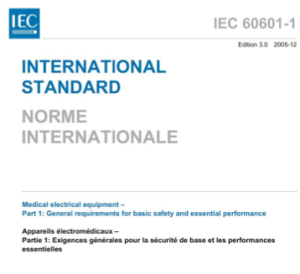This blog explains the IEC 60601 scope to help you determine if and how IEC 60601-1 applies to your medical electrical equipment.
The first question to ask about IEC 60601 Scope
One of the first questions clients ask before a project starts is, “Does this medical electrical product fall under IEC 60601-1?” Another common question clients ask is whether IEC 60601-1 applies to battery-operated medical devices. To answer these questions, we must review and understand the scope (sub-clause 1.1) of IEC 60601-1 to determine if and how the IEC 60601-1 Standard applies to a medical electrical product.
The title of IEC 60601-1:2005 (3rd edition) is Medical electrical equipment – Part 1: General requirements for basic safety and essential performance. The IEC 60601-1 Standard itself states, “This…Standard applies to…MEDICAL ELECTRICAL EQUIPMENT and MEDICAL ELECTRICAL SYSTEMS…referred to as ME EQUIPMENT and ME SYSTEMS.”
*Note: ALL CAPITAL LETTERS identifies a defined term for the IEC 60601 series of standards within this blog. “IEC” is an acronym for the International Electrotechnical Commission. IEC is a non-profit, non-governmental international standards organization that prepares and publishes International Standards for all electrical, electronic, and related technologies.
All clause references in this blog are to both IEC 60601-1:2005 (3rd edition) and IEC 60601-1:2005 (3rd edition) + Amendment 1:2012, or the consolidated version IEC 60601-1:2012 (edition 3.1), but the actual text comes from edition 3.1.
Definitions
The ME EQUIPMENT definition (sub-clause 3.63) is:
“…equipment…
a) provided with not more than one connection to a particular SUPPLY MAINS, and
b) intended by its MANUFACTURER to be used:
1) in the diagnosis, treatment or monitoring of a PATIENT; or
2) for compensation or alleviation of disease, injury, or disability.”
and “…having an APPLIED PART or transferring energy to or from the PATIENT or detecting such energy transfer to or from the PATIENT….”
Note: The above definition aligns well with the description of medical electrical devices in the European Medical Device Regulation.
From the definition above, we know that a device can have up to one power cord, or be hard-wired to the building’s power by one power line, and/or be battery powered.
We also need to understand the term APPLIED PARTS (sub-clause 3.8): “Part of…ME EQUIPMENT…in NORMAL USE necessarily comes into physical contact with the PATIENT for…” the device “…to perform its function.” Classification of the different types of APPLIED PARTS and other classifications (there are eight different classification criteria in the IEC 60601 Standard) need to be completed early in the process of setting up a test plan for design verification to determine the applicable testing requirements, and to develop an appropriate test plan.
Examples within Scope of IEC 60601-1:2005
Examples of electrical medical products fitting the definition above are broad and include battery-operated thermometers, gamma imaging systems, endoscopic cameras, and infusion pumps. IEC 60601-1 may also apply to many ACCESSORIES (sub-clause 3.3) used with ME EQUIPMENT.
Examples not within Scope of IEC 60601-1:2005
The scope of IEC 60601-1 also identifies which devices are not included in the IEC 60601 series:
- “in vitro-diagnostic equipment…IEC 61010 series;
- implantable parts of active implantable(s) … ISO 14708 series…;
- medical gas pipeline systems…ISO 7396-1…”
IEC 60601 & ISO 13485
Design verification must confirm that design outputs (i.e., – product specifications) meet design inputs (e.g., – product must meet IEC 60601-1 requirements).
Many projects don’t identify all the applicable IEC 60601 standards. This could cause multiple nonconformances during an audit by the national regulatory body (i.e., FDA, EU Notified Body), or that you don’t obtain approval to sell and distribute your device from the national regulatory body.
A test plan, with multiple test protocols, is developed from the product specification. This test plan should identify all the requirements of the IEC 60601 series of standards, in addition to any other applicable standards and regulations that apply to the device before performing device testing.
Third-Party Testing
IEC testing can be performed by a third-party test house (i.e., – a safety certification agency, such as a BV, UL, CSA, TÜV SÜD), an independent test lab (i.e., Medical Equipment Compliance Association), or the manufacturer can conduct the testing if they have the proper equipment, trained personnel and a good understanding (i.e., – used the Standard on several projects, and successfully tested previous similar electrical medical device(s) by a third-party test lab, and been approved by a national regulatory body) of the Standard (s). However, for OSHA compliance in the USA, IEC testing should be performed by an Nationally Recognized Testing Laboratory (NRTL).
Design verification reports generated from the test process are either the applicable IEC 60601, and IEC 80601 series of standards test report forms or the manufacturer’s generated test reports.
The Author
 If your company needs help with IEC 60601-1 gap analysis, preparation of the risk management file for the third edition, or training on the Standard, please contact Leo Eisner (the “60601 Guy”). Leo also created a training webinar series on IEC 60601-1, 3rd edition.
If your company needs help with IEC 60601-1 gap analysis, preparation of the risk management file for the third edition, or training on the Standard, please contact Leo Eisner (the “60601 Guy”). Leo also created a training webinar series on IEC 60601-1, 3rd edition.


Do video endoscopes need an IEC certificate? Considering that video endoscopes do in vitro-diagnostic and there is not any transfer of energy to or from the PATIENT.
Thank you for your reply.
Great question, but my friend +Leo Eisner is the expert on this. I believe that electrical safety requirements would apply, because the CCD in the endoscope is electrically powered. However, there are many classifications of electrical medical equipment. I checked the FDA classification and IEC 60601-1 was not listed, but I will ask Leo to add a comment here.
From what I understand, Endoscopes are included in IEC 60601-1, and in addition they have their own Particular Standard IEC-60601-2-18.
Most products have multiple IEC 60601 standards that apply. The IEC 60601-2-18 is a particular standard. Each product category could fall under one or more of these particular standards.
Does an electrical surgical instrument system used for fat harvesting and body contouring fall within the scope of IEC 60601-1?
Low level lasers for aesthetic purposes and lipoplasty systems are both regulated as Class II medical devices that require electrical safety testing under IEC 60601-1. Sometimes the collateral standards are not specified under the product classification codes, but you will find that there is electrical safety testing listed in the 510(k) summary of most of the predicate devices.
How do I know which clauses, sub-clauses of the standard are applicable to my Medical Device? Battery Powered, hand held device, for Hospital Environment.
You have to review the standard itself and you need specific information about your device. For battery powered devices, only certain clauses are applicable, but this is stated in the standard. Another factor is whether the device has an applied part, and finally the use environment can change the applicable standards. For example, lab equipment falls under a different standard, but labs are still within a hospital.
What are the requirements for a device to be considered mains powered? Is a battery powered camera considered mains powered if it is being charged during operation? Would an isolating switch that is enabled during use be enough to call it a battery powered device?
This response was provided by Leo Eisner of Eisner Safety.
When the device is disconnected from the power source, and not charging, it will fall under INTERNAL POWER (definition 3.45 – see definition below.) When the device is connected to the MAINS POWER, it will fall under mains powered. If you refer to 4.10.1 below, you will see you can connect to SUPPLY MAINS, connection to a separate power supply or be powered by an INTERNAL ELECTRICAL POWER SOURCE. Or you can combine in to a combination of these sources.
3.45 – Definition of INTERNAL ELECTRICAL POWER SOURCE
Electrical power source for operating equipment that is a part of the equipment, and which produces electrical current from some other form of energy. Examples include chemical, mechanical, solar or nuclear.
4.10.1 Source of power for ME EQUIPMENT
ME EQUIPMENT shall be suitable for connection to a SUPPLY MAINS, be specified for connection to a
separate power supply or be powered by an INTERNAL ELECTRICAL POWER SOURCE. Alternatively, a combination of these sources may be used.
The more specific questions asked required additional input that was communicated by Leo directly to Douglas Harvey.
Can dental units be described as ME EQUIPMENT? I mean without devices as turbins, micromotors, scalers… only chair, suction block and field lamp. Thank you for your help. Regards.
Hi Marek,
Dental chairs fall under the US product classification of NRU. They are class I devices and exempt from 510(k), pre-market notification. This means that design controls are not required. However, I don’t think that means that no electrical safety testing is required, because the device is also a powered device used in a clinical environment. In order to confirm this, I recommend contacting Leo Eisner at Eisner Safety (i.e., https://eisnersafety.com/).
Till the human existence in the earth, Medical electrical equipment will be the most necessary thing in the medical category.
Liked the article.
Thanks
Thank you for the positive feedback Shiva. Any suggestions for future blog postings?
Hello.
Is there a standard that non-electric devices? Doing a stretcher powered by hydraulics, the best I got is the 60601-2-52. Do you know a better standard to comply with? Thanks in advice.
Dear Luis,
Thank you for the question. I was not able to find any standards specific to hydraulic stretchers recognized by the FDA or on the AAMI store. However, there is a series of European standards that might be helpful: EN-ISO 1865-1, -2, -3 and -5. I found these on the following website: https://www.evs.ee/. For more help with a standard like this, Leo Eisner might be helpful at Eisnersafety.com.
Rob
Hi Rob,
If a device can only be operated using its internal power source, and then it is connected to a charger to ONLY charge the internal power source (i.e. operation of the device is disabled). Is the charger considered a “separate power supply”? I would argue no as the user cannot use the device while charging. I don’t think I need to list the make and model of the charger I used in testing/critical component list (7.9.2.3).; as this can be any generic USB charger. Would love to get your take on this. Thank you.
You will be required to conduct testing on the charging device or use a charger that already has IEC 60601-1 testing, because the “use” of the device includes maintenance activities.
When it comes to medical electrical equipment, there are several important considerations to ensure safety, effectiveness, and compliance. Nice explanation about the IEC 60601 scope.